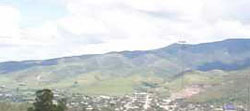Earthquakes Shake, Rattle, and Roll

For minutes after the violent shaking of an earthquake, the ground continues to rock imperceptibly. Seismologists are unclear about the cause of this so-called seismic coda, but the 9 April PRL presents new evidence that may resolve the question. While some seismologists assume that the coda comes from waves that scatter only once before reaching the surface, the authors found evidence that the vibrations reflect many times within the Earth before being detected. They used an array of seismometers that could distinguish several types of shaking and showed that energy is divided equally among them, as theory predicts for multiply scattered waves.
The seismic coda is an indistinct, broad-band reverberation, says Richard Weaver of the University of Illinois in Urbana. Modulated to the range of human hearing, it sounds “a little bit like clapping your hands in the bathroom,” or perhaps in a cathedral, where the echos of consecutive claps overlap. Seismologists’ computer models of codas usually assume that the vibrational waves radiating from an earthquake’s epicenter scatter only once before being detected.
While some physicists and engineers hypothesized that the coda comes from waves that scatter many times, they hadn’t proven it directly, so Weaver’s collaborators set out to do that. There are three types of seismic waves: surface waves, which travel along the surface; longitudinal waves, which move through the Earth like sound waves; and shear waves, where the shaking is “sideways” as the waves travel forward through the Earth. If the Earth acts as a highly scattering medium for these waves–as frosted glass does for light waves–the vibrations should quickly become randomized, and the energy of an earthquake should rapidly be distributed equally among all three types. This “equipartition” should hold even though most earthquakes initially put most of their energy into only one type of wave.
Weaver and his collaborators, led by Bart van Tiggelen and Michel Campillo of the Joseph Fourier University in Grenoble, France, analyzed data from 11 earthquakes near Chilpancingo, Mexico, recorded by the National Autonomous University of Mexico. A four-seismometer array allowed the researchers to discriminate among different types of motion in a way that would not be possible with a single seismometer. They measured the energy from each type of shaking and compared the results with their theory. The agreement was qualitative–better for some parameters than for others. Weaver attributes some of the discrepancies to local inhomogeneities in the Earth at the seismometer site. The results suggest that the behavior of a seismic coda does not depend very much upon the details of the specific earthquake. Such a general result is “the sort of thing physicists really love,” says Weaver.
Although he doesn’t doubt that codas come from multiply scattered waves, George Papanicolaou of Stanford University says that the theory in the paper does not account for enough details of wave propagation through the Earth, and he thinks more data are needed to justify its conclusions. But Joseph Turner of the University of Nebraska, Lincoln, says the simplified treatment was justified by the assumption of multiple scattering. “For me, this really settles the issue.” van Tiggelen adds that researchers should now be better equipped to learn about the Earth’s crust. “The shaking time is different in California than it is in Chicago,” he says. “We want to know why.”


